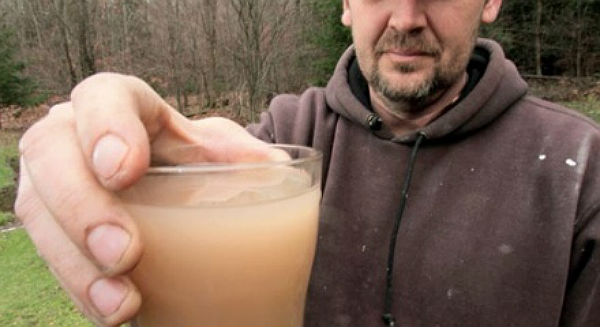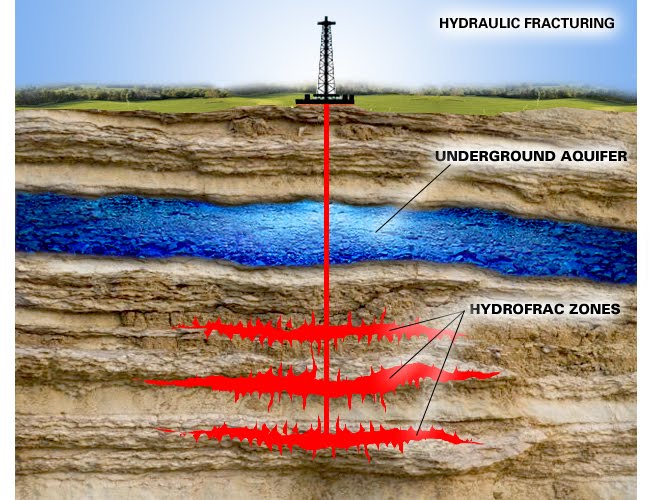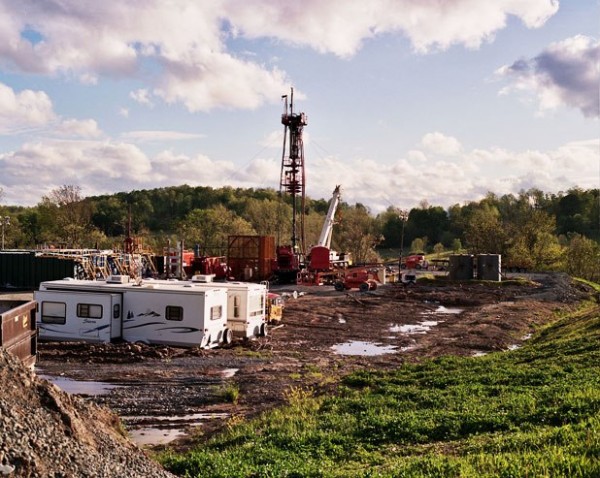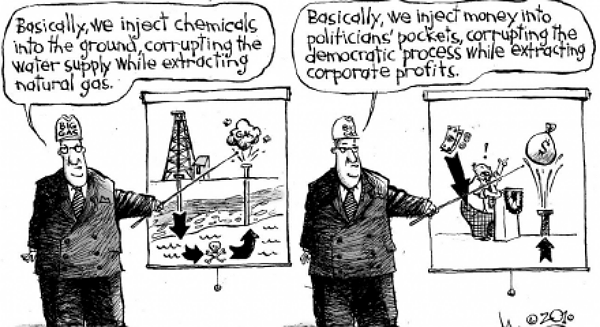Can fracking contaminate drinking water?

Hydraulic fracturing uses pressurised fluid to crack open deep shale rocks to release the methane trapped within them. Geologists say this potentially harmful fluid is unlikely to percolate up through a few kilometres of rock to reach the shallow aquifers that supply drinking water – but Avner Vengosh of Duke University in Durham, North Carolina, thinks the methane itself could do so. The gas would be an explosion risk.
Last year his team claimed drinking wells close to fracking sites in Pennsylvania were contaminated with methane – suggesting that it has been released by fracking. About 40 of the 158 Pennsylvania aquifers his team studied were unusually salty, contaminated with brine from salt aquifers that occur at the same depth as fracking operations. Cracks in the rock must have allowed the brine to migrate hundreds of metres upwards. It is possible that gas from deep fracking operations could travel in the same way.

Mike Stephenson of the British Geological Survey points that the process is likely to take millions of years, making it far too slow to pose a serious problem . However, the salt water must be moving upwards fairly fast otherwise Pennsylvania’s heavy rainfall would wash it out of the shallow aquifers. Gas would probably move even faster.
Residents of Dimock, Pennsylvania, are suing Cabot Oil & Gas Corporation for contaminating their wells. Residents in Dimock complained that hydraulic fracturing operations, or fracking, by Cabot near their homes had put methane in their water and endangered their health.
In a statement released on March 15, 2012, the EPA said its tests begun early this year found sodium, methane, chromium or bacteria, but at levels “within the safe range.” Two wells were found to have elevated levels of arsenic.

High levels of methane may have infiltrated private water wells and streams in Bradford County through small open spaces in a natural gas well that a drilling company was working to patch, state environmental regulators said Thursday. The description of the gas well failure was included in a letter from Department of Environmental Protection Secretary Michael Krancer to the Clean Air Council, an environmental group that commissioned a study last month that showed twice-normal concentrations of airborne methane in a roughly two-square-mile area of Leroy Twp. where the gas was found bubbling in streams and water wells.
Fracking is a process that injects water, sand and chemicals into deep shale formations to free trapped natural gas. Methane in aquifers located above the shale strata, for instance, in Pennsylvania, United States, has been attributed by some to be the result of contamination caused by the hydraulic fracturing process. If boreholes aren’t properly sealed, gas can leak out of them. Around 184,000 wells were drilled in Pennsylvania before records were kept. Most of these probably aren’t sealed, so if someone fracks near one the gas could escape up it. Last December an industry-funded study claimed that the methane in the Pennsylvanian aquifers was chemically different to that liberated from the shale during fracking.



Sources: Proceedings of the National Academy of Sciences, Oil & Gas Journal, Coalition for Healty County
Featured image: Whistle-blower Scott Ely holds up water from his aquifer in Dimmock (Credit: Michael Mullen)

[…] See how scientists believe fracking contaminates our drinking waters supplies here. […]
look at the fracking picture
they drill threw the aquifers
then into the next layer of rock
when they pull the drill head out what happens?
I will tell you they dont and cant plug the hole so all the crap they just pumped into that well rises into the aquifers
god help use all this for profits
We cannot trust the Government, the regulators nor the frackers themselves. History has proved this time and time again. Nothing will ever change as far as this is concerned.
So if you are pushing for better and proper regulation you are wasting your time. This is why I`ve been campaigning for a total ban for the last couple of years.
Having had six years previous experience in the N.Sea drilling industry, I have an advantage in understanding over the general public and this is why I don`t focus entirely on the fracking itself here and now.
Ever heard of failing well integrity? Hundreds of thousands of plugged and abandoned wells around the world are leaking. The drilling companies are long gone from those sites and nobody wants to take responsibility or cover the cost of trying to plug them for good. The reason is because it`s impossible to permanently seal off a well for good. When a well is drilled, casing is run and cemented in. The cement goes between the well bore and the outside of the casing. When the well is plugged and abandoned, the inside of the casing has a `plug` set into it and cement is pumped in on top. Once this is done there is no way of monitoring the well inside nor outside the casing to ensure the well is kept sealed. Do your own research and prepare to be very shocked. If you are against fracking for pollution reasons, it won`t matter one iota how good the regulation is today or the next 20 years, these wells WILL fail in the future long after the frackers and their investors have made their millions and left the scene. Or not so long after.
http://www.alkane.co.uk/ourcompany/alkane-news/44-5-april-2012-seven-star-biddulph-moor-approved-planning-permission
If 7 Star had no interest in this site, how long do you think these wells would have remained unchecked and leaking and if spotted by a member of public, who do you think would have to foot the bill? The health and safety remains with the site not with Shell who are long gone. That means the local council would have to foot the bill to attempt an impossible fix. That means tax payers money down the drain.
Each day hundreds of thousands of abandoned leaking oil wells and natural-gas wells spew toxic pollutants into the environment—and tens of millions more will soon join them—thanks to fatally flawed gas and oil-well capping and lax or nonexistent industry and government oversight.
http://ecohearth.com/eco-zine/green-issues/1609-abandoned-leaking-oil-wells-natural-gas-well-leaks-disaster.html
Just take a look at these next few links and then go on to do your own research, but don`t stop there. Do as I am doing and push for a complete ban, not just on fracking, but new deep sea projects. In fact, push for a ban on all hydrocarbon extraction and focus on clean renewable s.
More than 27,000 abandoned oil and gas wells lurk in the hard rock beneath the Gulf of Mexico, an environmental minefield that has been ignored for decades. No one — not industry, not government — is checking to see if they are leaking, an Associated Press investigation shows.
http://www.treehugger.com/corporate-responsibility/27000-abandoned-oil-gas-wells-may-be-leaking-in-gulf-of-mexico.html
A study of a gas field in Queensland, Australia has found 44% of gas wells leaking. The report adds to a growing body of evidence suggesting that gas drilling inevitably leads to water contamination as gas escapes from boreholes.
http://gasdrillinginbalcombe.wordpress.com/2012/03/14/44-of-wells-leaking-at-australian-gas-field/
Government reports have warned for decades that abandoned wells can provide pathways for oil, gas or brine-laden water to contaminate groundwater supplies or to travel up to the surface. Abandoned wells have polluted the drinking water source for Fort Knox, Ky., and leaked oil into water wells in Ohio and Michigan. Similar problems have occurred in Texas, New York, Colorado and other states where drilling has occurred.
http://www.propublica.org/article/deteriorating-oil-and-gas-wells-threaten-drinking-water-homes-across-the-co
Sorry if this is a bit of a long read, but proper research of the whole problem is required rather than just jumping on the fracking ban wagon.
If these companies try to tell you that new technology can plug these fracked wells once all the oil or gas has been extracted, just refer them to all those wells that they drilled in the past that are leaking and need fixing. The cost of trying to fix a plugged and abandoned well is much more expensive than drilling the well in the first place. The existing cement and casing will need to be milled out and new plug pumped in. This is a total waste of money because there is no absolute guarantee of 100% well integrity in the future due to changes in underground formation pressures, corrosive elements, natural ground movements and even unforeseen faults that can rupture even the best plug and abandon job on the planet.
Proper and adequate regulation on frack jobs today will NOT protect our future.
Fracking is an extremely dangerous activity that is destroying the earth – it must be stopped.